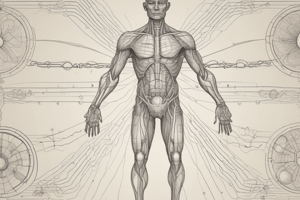Podcast
Questions and Answers
Differentiate between the central nervous system (CNS) and the peripheral nervous system (PNS) in terms of their functions.
Differentiate between the central nervous system (CNS) and the peripheral nervous system (PNS) in terms of their functions.
The central nervous system (CNS) consists of the brain and spinal cord and serves as the central office, while the peripheral nervous system (PNS) facilitates the harmonious secretion of various functions and smooth body coordination.
Explain the role of the Nervous System (NS) in the control and coordination of the human body design.
Explain the role of the Nervous System (NS) in the control and coordination of the human body design.
The Nervous System (NS) controls movement and receives signals from the senses. The brain, as the central office, processes these signals to facilitate body coordination and control.
Describe the role of the endocrine system (ES) in maintaining the body's internal environment.
Describe the role of the endocrine system (ES) in maintaining the body's internal environment.
The endocrine system (ES) produces and secretes hormones, acting as messengers to regulate various functions such as metabolism, growth, and development, thus maintaining the body's internal environment.
What are the key components of the central nervous system (CNS) and their respective roles in human body design?
What are the key components of the central nervous system (CNS) and their respective roles in human body design?
How do the central nervous system (CNS) and peripheral nervous system (PNS) interact to maintain body movement and coordination?
How do the central nervous system (CNS) and peripheral nervous system (PNS) interact to maintain body movement and coordination?
Flashcards are hidden until you start studying
Study Notes
- Balaji Mental & Aaj is our quick review session on chapter control and coordination, specifically because it is quick, in the context of human body design.
- To effectively design for body control and coordination, we need systems such as a design responsive system (SI), a cardiorespiratory system (CRS), an excretory system (ES), and an endocrine system (ES).
- The Nervous System (NS), one of our two main systems, controls movement and receives signals from our senses. Our brain, which serves as a central office, processes these signals.
- In a normal system like ours, the beta (the component of the NS we're focusing on) separates into two parts: the central nervous system (CNS) and the peripheral nervous system (PNS).
- The clothes on our body move due to the harmonious secretion of various functions by the CNS and PNS. This facilitates smooth body coordination and control.
- The CNS, which resembles a central office, consists of a brain and a spinal cord. This is where our brain and spinal cord, or central components, reside.
- Additionally, besides the break and motherboard-like component (our brain), there is also a motherboard-like component called the spinal cord, which plays a key role in transmitting signals.
- Our body's movement and coordination is maintained by the interplay between the CNS and PNS.
- The ES, the second main system, plays a crucial role in maintaining our body's internal environment. It consists of the endocrine glands and hormones which control various body functions.
- The ES produces and secretes hormones, which act as messengers, to regulate various functions such as metabolism, growth, and development.
Studying That Suits You
Use AI to generate personalized quizzes and flashcards to suit your learning preferences.



